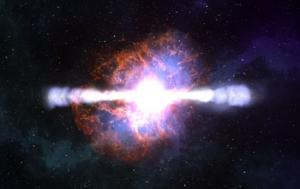A new theory to explain the high-energy gamma-ray emissions from collapsing stars has been put forward by an international team of researchers. Their results will be published shortly in the Monthly Notices of the RAS.
Long duration gamma-ray bursts (GRBs), first discovered in the 1970s, are the most explosive events in the Universe. Finding out what happens during these cataclysmic events is a major challenge, partly because they usually occur at the edge of the visible Universe and partly because the bursts last only a matter of seconds.

Observations accumulated over the last decade have led to a consensus that at least some GRBs mark the death throes of a giant star as its core collapses to form a black hole. Until now, it has generally been thought that the black hole ejects a jet of plasma (extremely hot gas) which is blasted outwards at close to the speed of light.
This theory is called into question by a new study led by Pawan Kumar from the University of Texas. The work has been accepted for publication in the journal, ‘Monthly Notices of the Royal Astronomical Society’.
Magnetic Outflow
Scientists have long speculated that the gamma-ray emission we see comes from fluctuations in the speed of the ejected material. The faster and slower ejecta collide, producing shocks in the jet which result in the emission of gamma-rays. Although this internal shock model is the standard explanation, it relies on the jet consisting of ordinary matter -- the same sort of material that we are made from -- or what scientists call baryons.
Now, however, Pawan Kumar and colleagues have cast doubt on this model. Instead of the GRBs being generated by internal shocks, Kumar’s team finds that the jet is actually a powerful magnetic outflow which transports huge amounts of energy away from the collapsed star.
Using data from the Swift satellite, Professor Kumar’s team has analysed a sample of 10 gamma-ray bursts that were recorded between January 2005 and May 2006. In each case, Swift collected gamma-ray, X-ray and optical light immediately after the explosions were detected. Such multi-wavelength observations are essential if the researchers are to understand what happens after the brief burst fades and the source object is only visible in X-rays or visible light.
“Swift is uniquely capable of such simultaneous multi-wavelength observations,” said Neil Gehrels of NASA’s Goddard Space Flight Center, Principal Investigator for the Swift satellite.
The new study reveals the physical process responsible for the generation of gamma-ray radiation and the distance from the black hole where this radiation is produced.
"The gamma-ray source is located about 10 billion km from the black hole, or 100 times further than previously thought,” said Professor Kumar. “This and several other lines of evidence put forward in our work suggest that the outflow is dominated by the magnetic field.”
The data indicate that a magnetic jet decays into gamma-rays. The subsequent interaction (of the jet) with the surrounding gas causes intense heating and this produces an afterglow that is seen at X-ray and visible light wavelengths.
Dr. Paul O’Brien from the University of Leicester, a co-investigator on the project, said, “In just a few seconds gamma-ray bursts emit as much energy as the Sun does in 10 billion years. The Swift observations are telling us that this emission is due to an outflow in which magnetic fields transport the energy. If confirmed, this will alter our view of how these objects work.”
“Using the Swift data we can accurately measure the times when the prompt emission stops and the afterglow becomes visible,” said Richard Willingale, also from the University of Leicester. “These times constrain the distance of the emitting region from the black hole and hence the physical processes involved.”
Since its launch on 20 November 2004, Swift has observed over 200 gamma-ray bursts and provides prompt data on almost all of them.
“Swift can turn and observe a gamma-ray burst with its X-ray and optical telescopes in just a few tens of seconds,” said Professor David Burrows from Pennsylvania State University, lead investigator for the X-ray telescope on Swift. “This capability allows us to capture a snapshot of the early emission which carries information on the physical processes involved.”
Dr Silvia Zane, from the Mullard Space Science Laboratory said, “This is going to revolutionise our understanding of the cause of such explosions.”
Note: This article has been adapted from a news release issued by Royal Astronomical Society.





Comments